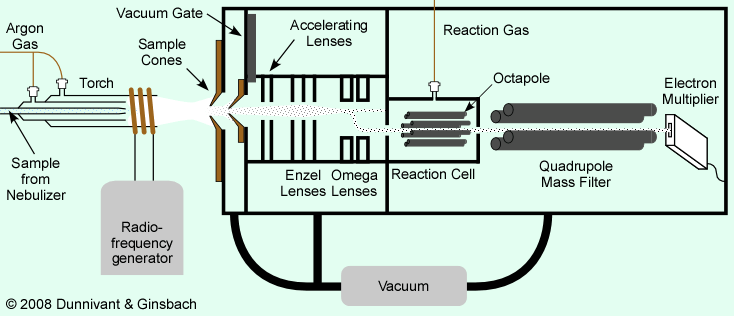4.2 Components of a Mass Spectrometer
4.2.1 Overview:
The sample introduction systems (automatic sampler to torch) are almost identical on optical and mass spectrometry ICP units (Section 3.3.2). While the ICP-AES is interfaced with an optical grating system, the plasma from an ICP-MS must enter into a vacuum so that atomic cations can be separated by a mass filter. The common components of a modern ICP-MS are shown in Figure 4.1 (the sampling interface is not shown). The torch and the plasma were discussed in Section 3.3.3 (Animations 3.1 and 3.2). For MS systems, the detector is axially aligned with the plasma to follow the flow trajectory of the argon. After the analytes are ionized in the plasma at atmospheric pressures, they must enter into a low pressure system before they can be accelerated and separated by mass to charge (m/z) ratios. This pressure difference is accomplished with a series of cones between the plasma and the mass analyzer. The first cone, the sample cone, is a protruding cone, usually made of Ni, that has a small hole (1.0 mm in diameter) at its tip to allow the cations and Ar to pass. The next chamber interface contains another cone (the skimmer cone) with an even smaller diameter hole (equal to or less than 0.1?mm in diameter) that allows less sample to enter into the low vacuum chamber (~10-5 torr which is about 10-8 atm). The smaller hole in the skimmer cone helps maintain a lower vacuum in the mass filter chamber. As the cations enter this second chamber, they are exposed to accelerating lens (negatively charged plates) that place a fairly uniform amount of kinetic energy on the cations. Then the neutral particles and photons are filtered out by a second type of lens (Section 4.2.4). The specific design of the lens varies among different manufactures despite the fact that they accomplish the same goals. Figure 4-1 shows an Omega style filter that serves this purpose. Most higher-end systems have a reaction cell placed just before the mass filter. This cell removes polyatomic interferences (that have the same mass as the analyte of interest) by gas phase chemical reactions (Section 4.2.5). Then, the cations enter into the mass filter that separates the different atoms with respect to their mass to charge ratio (m/z) before they eventually enter into a detector. Mass analyzers that have higher than unit resolution, such as a double-focusing mass filter, bypass the reaction cell since polyatomic interferences have different masses at three or four significant figures. Given the large amount of data and the extremely short scan times of the MS, computer operation and computer enhanced data collection are required. The most variation between various ICP-MS manufactures is the presence or absence of a reaction cell and the type of mass filter.

Figure 4-1. A Common ICP-MS with a Quadrupole Mass Filter.
| Frank's Homepage |
©Dunnivant & Ginsbach, 2008